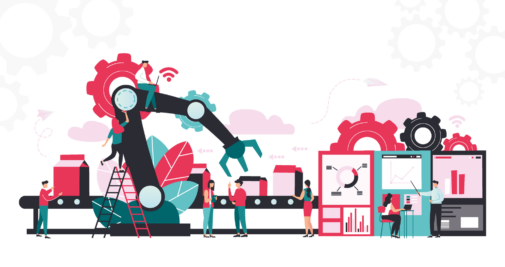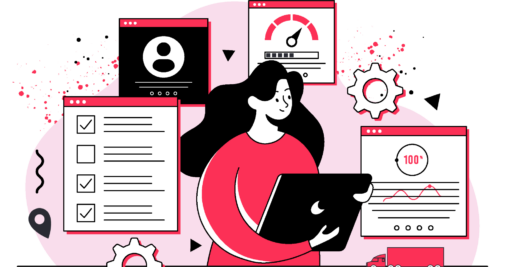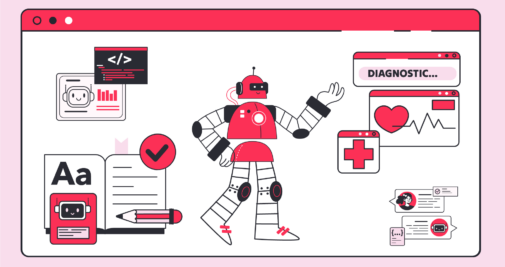This website uses cookies so that we can provide you with the best user experience possible. Cookie information is stored in your browser and performs functions such as recognising you when you return to our website and helping our team to understand which sections of the website you find most interesting and useful.
Succeeding in business comes down to an irritatingly simple truth. It’s this:
“Make more decisions that are probable to win than flip-of-the-coin ones.“
However, as is the case usually, behind a very simple statement lies a complex apparatus. In this case, it’s the one aiming to remove the guesswork from crucial business decisions.
It’s a rare treat in any field – reserved for the privileged few or naive lots – that you get tipped off a trade secret with jaw-dropping outcomes. You know, win big, win quick scenario. It is why successful organizations are deciding to take a hard route – that of harvesting new or leveraging existing data, adopting new technology and dealing with the reluctance of the employees to embrace the big change. Hence business intelligence systems are bringing in results and it’s market is about to reach $43.03 billion by 2028.
The trend here is obvious. Many decision-makers are starting to realize an evident state of affairs. When left to their own devices, C-level managers show a tendency to rely on biases. They’re known to draw business decisions based on their fortunate (and unlikely) past wins or worse, get home-blinded and fail to react to their shortcomings. On the contrary, when data-driven and/or externally consulted they focus on solving the most vital problems. The ones that take a bit more effort to figure out but are sure to carry a massive impact on the company’s bottom line.
If you’re in the second group – or wish to join – here’s the concrete evidence as to why (and how) BI benefits could forge ahead your company’s prosperity and lead to a better understanding of the role it plays in decision-making.
First, what is business intelligence?
Business intelligence (BI) is a valuable tool that can help organizations answer the most critical challenges and process inefficiencies with the help of business analytics reports. Through the BI process, companies are able to collect, integrate, organize, and track accurate information from internal and third-party systems, and use it to obtain valuable insights.
From visual reports and BI dashboards to integrated systems and queries, the range of BI tools allows companies to analyze the right data from multiple sources – through comprehensive, centralized, and point views. More than anything else, having access to clean, structured data is critical to gain a competitive advantage and get the most out of any BI system. It’s the source reason why implementation takes as long.
By utilizing the power of business intelligence tools, businesses are well-equipped to thrive in today’s competitive landscape by turning blind spots into actionable insights.
What can business intelligence be used for?
Business Intelligence is becoming the go-to solution for businesses seeking to optimize processes across development, marketing, and operations. By leveraging BI software – on-premise or through the cloud – businesses can gain insights into customer behavior, cross-franchise sales performance, and key financial bottlenecks.
In turn, this allows them to set up strategic decision-making and remain competitive. With powerful business analytics tools like customer segmentation, predictive/prescriptive analytics, and forecasting capabilities, businesses can optimize and prevent money leaks from critical business processes. Moreover, with comprehensive dashboards providing access to customer information, performance metrics, financials, and more – there’s no doubt that the benefits of business intelligence in any of the following areas can result in fruitful returns.
- streamlining operational efficiency
- revealing financial inefficiencies
- predicting customer behavior
- improved sales performance
- creating worthwhile and sustainable processes
- tracking company’s key performance metrics
- faster response to changing market demands
- omnichannel customer support & satisfaction
In one of their recent surveys, TDWI found out most companies primarily see these two purposes as very important.

BI Benefits and The Power of Business Intelligence
Every industry, company, and scenario is unique in how business intelligence solutions are deployed. There’s rarely a one-size-fits-all scenario.
Thomas H. Davenport’s shared a succinct advice when he said “Decisions are the unit of work to which business intelligence initiatives should be applied”. It captures the essence of how BI tools must be focused on refining decisions if they’re to reap rewards and multiply profit margins. Enforce the notion that business intelligence is not just a technology initiative but a means of fine-tuning decision-making. In a long run, intelligent reports are supposed to help everyone involved – even your outside stakeholders.
With that in mind, there are those cross-industry benefits of business intelligence that companies of any profile could harness. To prove just that, we’ve put together a short list of perks attainable to most commerces, by and large. In addition, we’ve powered each benefit with a real-life success story – either from one of Net Group’s existing clients or other global renown companies.
Let’s take a look at the four benefits of business intelligence we think made a massive difference for these companies.
#1 Gain operational efficiency – A story of Toyota Baltics
There are two ways to work with the data. One involves human input – a.k.a manual work. The second one is – you guessed it – automation. Generally, we want more of the second and less of the first.
“In most processes – where risk and compliance are properly assessed – automation ensures time-efficiency, less expenses and that there are fewer errors involved and higher employee productivity.”
According to Anders Abel, our Head of Digital Commerce in Net Group, unknown or neglected processes can decrease the profit as much as the optimized operational flow can advance it. Deciding to improve and interlink critical processes is therefore vital to rejuvenate the revenue curve.
Success story
In the case of Toyota Baltics – a long-term partner of Net Group – their success materialized due to operational efficiency improvements. Their work mostly revolves around managing and evaluating a massive chain of vendors in the Baltics region. In order to track the performance metrics they use a Power BI as a hands-on management tool – to gather the sales and service data from each Vendor. This helps them run operations from a central spot – their headquarters.
By adopting BI tools and using state-of-art custom reports, they managed to streamline the process of car model transfer/allocation and car callbacks based on specific performance and service response metrics. A few of the key metrics that allowed things to run as desired were car callback rates, per-location sales performance, sales metrics per car model and location, service performance, etc. Once these targeted improvements set place, Toyota reported having massive increase in valuable business insights and overall customer satisfaction.
#2 Eliminate financial inefficiencies – A story of O2 Ireland

Essentially, any operational inefficiency in critical areas carries a direct or roundabout impact on balance sheets. Therefore, any benefit reaped from the list will in fact spill over to positively impact finances.
However, companies do often come in with the request for a solution they know will end up cutting costs significantly. Sometimes, they can’t even recognize the weaknesses that are causing a downpour of money. To stop their enterprise from leaking money, many decision-makers try to put data to purpose. They want to identify or figure out a way to eliminate certain operational bottlenecks they know are burning holes in their pockets. One of these financial bottlenecks – in our experience serving the clients – happen to be:
- An outdated buying process
- Keeping customer and business data in silos
- Failing to notice major expense categories
- Not reducing significant risks the customers have when using product/service
- Disengaged employees
Success story
O2 Ireland, now known as a Virgin Media 02, a large telecommunications provider and Telefonica SA subsidiary, was experiencing one of the listed issues. A big portion of their customer base is buying pre-paid SIM cards during their stay in Ireland. They pay a brief visit to the country, use the service, and shortly after leave the borders mostly never to use the same card again.
O2 identified an unnecessary marketing spend on such customers. And how couldn’t they? There was almost zero chance of repeat business and tons of waisted marketing efforts that only resulted in churn.
However, segmenting such customers was an issue. To them, at the time, they were just, customers. In the urge to stretch out this financial bottleneck, O2 went on to employ data warehouse and business intelligence software. With a unified data warehouse strategy, O2 was able to gather all the helpful data from the scattered processes on to a single infrastructure. From there, it was easy to process the data and identify 65% of the customer base that used their service regularly.
#3 Predict customer behavior – A story of big players
Anticipating people’s needs and their behavior lies at the core of sales and marketing performance. Call it “reading customer’s minds” because that’s basically the aim. We’ll call it consumer behavior analytics or reading customer needs. It is something business intelligence tools are capable of automating and channeling over to dashboards.
What’s the benefit of customer behavior prediction? Well, creating average buyer profiles, personalized experience, higher retention, improved customer satisfaction, just to name a few… Moreover, the possibility of optimizing product development and predicting sales trends based on customer data makes it even more appealing.
To predict the behavior companies lean towards machine learning and deep neural analysis. They don’t just narrow the focus on internally available data. No, they reach a lot further than that. Think consumer price index, disposable personal income, consumer sentiment, etc. If you have access to this quality data, intelligence can help you take advantage of it.
Success stories
To find success stories you don’t have to look past your favorite streaming service and darling gadgets. Yes, both Netflix and Amazon – big players you should be learning from – are “owning the analysis game”.
By analyzing the behavior patterns of its users, Netflix not only optimized the feed down to near-perfection. Into the bargain, they keep producing shows users love thanks to thanks to scrutinized data patterns. One such example is House of Cards. The famous American TV series came to fruition thanks to three major findings that happened before production set foot: users love director David Fincher, they love Kevin Spacey, and they love the story of the original, British version of House of Cards. Netflix saw the data, made the links, and got a win. A pure example of BI tools in action.
Amazon on the other hand- needless to say anything about the portfolio – remains a retail force thanks to the same predictive data analysis. As much as 92% of its user base claim they’re more likely to buy from Amazon than any other e-commerce website. Credit that to many factors. However, be certain that such amazing results are a mere reflection of their ability to provide exactly what their customers need. Just look at the data they collected through their surveys: 99% of consumers are happy with product assortment, and mind-bogglingly 95% are satisfied with the relevancy of Amazon’s search results.
#4 Be energy efficient and sustainable – A story of Vermaat and a district heating company
In recent years sustainability is getting a mainstream status – with all the right reasons. Remove all the nitty-gritty and it does intend to help people and the planet. It’s what we need as a collective but find hard to adapt and relate to on a company level.
Why, you may (not) wonder? Well, making your firm sustainable means changing business models, processes, ecosystems, and internal culture. It’s frightening for employees. It demands a notable sacrifice without any certainty in profitable outcomes, right?
To some extent, this is true. However, many technological advancements are also moving in the same sustainable direction – that of more things done with less energy spent. It’s the goal of your establishmentn as a whole. BI solutions, by processing numerous data sources from a central data warehouse, are helping organizations stay on top of their energy consumption.
“Exclude sustainability legislations from a formula, and you’ll notice business intelligence essentially boils down to energy and waste-saving activities.”
More on that note – sustainability compliance. BI can support complex LCA (Life Cycle Assessments) measurements and unite more data types to create a full picture. Here’s what we mean by this: Company’s activity-based footprinting data – the one showing the total impact of the product on its environment – can be weighted against the cost data. This results in a strengthened decision-making process that takes into account multiple factors – not just sustainability, but also financial evidence.
Success stories
Vermaat – a Dutch, big-league player in the hospitality branch – was finding it hard to run their environmental footprint calculations. A large sum of which depends on a supply chain – just think of emissions needed for transportation. To power up its sustainability efforts, Vermaat used a BI system to gather external supplier data. They then managed to create full-scale footprint measurements – using their own and suppliers’ data – to know just how much they are impacting an ecosystem.
In a truly eco-friendly and customer-oriented fashion, they then decided to share enriched data through their website. By linking purchase per location raw data with a footprint, they displayed nicely visualized charts on the sustainability dashboard.

Here’s yet another fine example right from the Net Group’s kitchen – a case of a data-driven district heating. Their heat producing plant pump provides heat for residential and commercial purposes through a pipe network. As heat gets pushed through pipes, some energy loss is inevitable.
To optimize their distribution, the company wanted to know just how much heat is lost on a pipe level. Thanks to the accurate data structurization and complex calculations they managed to have this same data visualized on a BI dashboard. This in turn resulted in massive savings in cost and process efficiency.
What are BI benefits?
Business intelligence tools (BI) help companies answer the most critical business challenges. There are number of perks to using this critical tool including increased efficiency, eliminating financial inefficiencies, predicting customer behavior, and being more energy efficient. By utilizing BI, companies gain remarkable strategic and operational advantages. These advantages apply across industries, as evidenced by a number of successful real-life stories.



